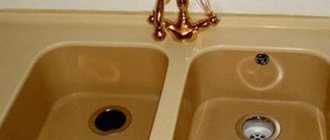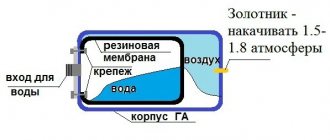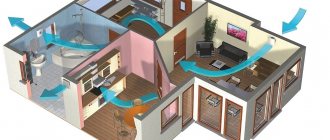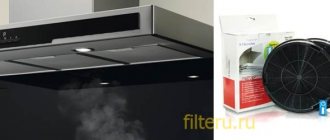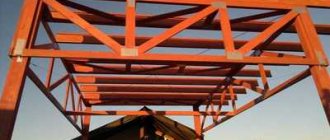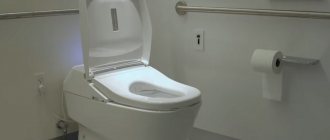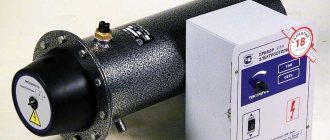Brief overview of modern models
To get an impression of the brands and models of water heaters, let’s look at several devices from different manufacturers.
Heaters KSK-3, produced at the company T.S.T.
Specifications:
- coolant temperature at the inlet (outlet) - +150°C (+70°C);
- inlet air temperature – from -20°С;
- working pressure – 1.2 MPa;
- maximum temperature - +190°C;
- service life – 11 years;
- working resource – 13,200 hours.
External parts are made of carbon steel, heating elements are made of aluminum.
The Volcano mini water fan heater is a compact device from the Polish brand Volcano, characterized by practicality and ergonomic design. The air flow direction is adjusted using controlled blinds.
Specifications:
- power within 3-20 kW;
- maximum productivity 2000 m?/h;
- heat exchanger type – double row;
- protection class – IP 44;
- maximum coolant temperature 120°C;
- maximum working pressure 1.6 MPa;
- internal volume of the heat exchanger is 1.12 l;
- guide blinds.
Galletti AREO heater made in Italy. The models are equipped with a fan, a copper-aluminum heat exchanger and a drainage tray.
Specifications:
- power in heating mode – from 8 kW to 130 kW;
- power in cooling mode – from 3 kW to 40 kW;
- water temperature – + 7°C +95°C;
- air temperature – 10°C + 40°C;
- working pressure – 10 bar;
- number of fan speeds – 2/3;
- electrical safety class IP 55;
- motor protection.
In addition to the devices of the listed brands, on the market of heaters and water air heaters you can find models of the following brands: Teplomash, 2VV, Fraccaro, Yahtec, Tecnoclima, Kroll, Pakole, Innovent, Remko, Zilon.
Types of air heaters
The efficiency and heating rate of air from a steam heater is higher than that of electric and water heaters
Duct heaters are classified according to the type of coolant. The following types are distinguished:
- Electrical. A metal heating element is used as a heating element, which operates from the mains. The device is easy to install and install. The power is designed to serve a room up to 100 sq.m.
- Mermen. These are devices in which water circulates through pipes. Used in ventilation systems in public and industrial premises. It is necessary to install the water heater piping unit.
- Steam. A heater powered by steam has a high efficiency and a high heating rate. The steam is heated to a certain design temperature. Suitable for installation in industrial buildings with a source of water vapor. The piping of a steam air heater for supply ventilation is complex, so it should only be done by specialists.
The choice of the optimal system depends on the type of room, its purpose and capabilities.
Classification
To create an optimal microclimate in the building, a calorific heating system is used, that is, forced heating using equipment that is installed in air ducts.
Depending on what coolant is used, there are 4 types of heaters:
- Steam - used most often in industrial enterprises where steam production is provided for by technological processes.
- Electric - this option is the easiest to install (you only need a power source to heat the built-in heating elements), but it requires a lot of electricity consumption. The use of an electric heater is considered appropriate only in facilities whose area does not exceed 150 m²
- Water - this type of heater operates on the basis of hot water and is installed in ventilation systems with a rectangular or round cross-section in areas over 150 m². This type of heating is reliable, practical, easy to maintain and inexpensive.
A special feature of the heater is that the composition of the air flow coming from the street should not be sticky, fibrous, or contain solid particles. Permissible dust content is no more than 0.5 mg/m³. Minimum intake air temperature -20 °C.
When choosing a heater, the following factors are taken into account:
- room area;
- weather conditions in a given climate zone;
- ventilation power.
The heater is installed in the inside of the ventilation shaft, so it must correspond to its parameters (configuration and size).
If the performance is low, the device will not be able to warm up the air masses.
If it is not possible to install a heater with the required parameters, then several mechanisms with lower power are mounted in series.
Schemes and types of designs of UTK mixing units
The mixing unit is built according to a three-way control scheme
Ball valves 1 serve to disconnect the unit from the heating network.
There is a filter 2 for hot water on the supply line of the unit. When dirty, the filter element must be cleaned.
A three-way control valve with a servo drive 3 of proportional control is installed on the supply line of the unit. Input B of the valve is connected by a bypass to the return line of the unit. A check valve 5 is installed on the bypass to prevent coolant from flowing from the supply line to the return line, bypassing the air heater. A circulation pump 4 is installed on the supply line of the unit to ensure circulation of the coolant through the “small” circuit.
Equipment selection
It is better to choose brass ball valves for piping the heater - they last longer.
The elements that make up the system do not differ depending on the chosen circuit. To select the right components, you need to use the following recommendations:
- All fittings must comply with technical specifications. They are calculated based on the maximum temperature and pressure.
- The diameter of the elements must correspond to the size of the heating system pipelines.
Ball valves made of steel or brass should be selected as shut-off valves. For pipes with a diameter over 50 mm, flanged valves are required.
To simplify the work, buy taps with union nuts. To limit the flow, check valves are selected and placed on the return line or bypass of the units.
To control temperature and pressure, pressure gauges and thermometers are purchased. The temperature sensor is placed on the supply and return lines in front of the heater. The pressure gauge is installed in the pump group.
To create optimal coolant movement, install a circulation pump. It is mounted on an adjustable section, where it helps overcome hydraulic resistance. Additional parts include filters, valves, valves.
Automated air heating in supply ventilation
Options for constructing round and rectangular ventilation shafts - the system is automated
- The operation of the equipment is controlled using a control panel (CP). The user presets the mode for regulating the supply air flow and temperature.
- Using a timer, the heated ventilation system automatically turns on and off.
- Equipment that provides heating can be connected to an exhaust fan.
- Heaters are equipped with a thermostat that prevents fire.
- A pressure gauge is installed in the ventilation system to monitor pressure differences.
- A shut-off valve is installed on the supply ventilation pipe; it is designed to block the entry of incoming wind masses.
(no votes yet)
Installation and connection features
Assembly and connection work must be carried out by professional workers from a specialized company. Before starting equipment installation work, it is necessary to check the condition of all elements and components of the mixing unit, the integrity of the insulation of the electrical wires of the drive and circulation pump.
Requirements for installation of electrical equipment
- The pump must be connected to the electrical network using a three-wire cable.
- It is necessary to install a junction box on the pump casing, where the phase, neutral and ground connections are connected. The terminals must be accessed by unscrewing the screw element in the middle of the protective cover of the box.
- The electrical cable must be removed from the junction box through an insulating ring.
- It is prohibited to supply current to the electrical cable until installation work is completed.
- Maintenance work must only be carried out with the mixing unit switched off.
To prevent emergency situations during the operation of mixing hydraulic units of ventilation systems, it is necessary to accurately calculate and select the standard sizes of valves, additional elements, pump power, etc. that meet the requirements.
Adjusting the heating process
There are 2 types of heating adjustment:
- quantitative – temperature adjustment occurs due to changes in heat resource consumption;
- high-quality - this option uses a change in the parameters of the heat carrier while maintaining constant consumption of heat resources.
Heater thermal power reserve
9. Determine the thermal performance reserve of the adopted heater(s). ((q - Q) / Q) • 100 q - actual thermal power of the selected air heaters, W; Q is the calculated thermal power for heating the required volume of air, W. The actual thermal performance of the adopted steam-air heater must be greater than the calculated one. The range of the permissible percentage ratio of actual and calculated power, according to various sources, can be from 96 to 120 (from - 4 to 20)%. In any case, you need to strive for the closest possible equality of power (actual performance = 100 - 110% of the calculated one). If, during the calculation, the difference is greater than the above figures, a recalculation should be made.
An example of calculation and selection of a KPSk heater. Step-9
Select a suitable KPSk heater for heating 6500 m³/hour from a temperature of -28°C to +29°C. The coolant is dry saturated steam with a pressure of 0.1 MPa. 9. We calculate the discrepancy between the actual and calculated thermal power of the selected heat exchangers ((104653 - 133426) / 133426) • 100 = -21.6% - for the KPSk 2-10 air heater ((150642 - 133426) / 133426) • 100 = 12.9% - for heater KPSk 3-10 ((188874 - 133426) / 133426) • 100 = 41.6% - for heater KPSk 4-10 104653, 150642, 188874 - actual thermal power of the selected steam heat exchangers, W; 133426 — calculated thermal power for heating a given volume of air, W. -21.6, 12.9, 41.6 — thermal performance reserve of the selected air heaters. Of the considered models of heaters KPSk number 10, only the three-row air heater KPSk 3-10 corresponds under given conditions to the recommended ratio of actual and calculated power.
Strapping methods
The piping is a frame made of reinforcement, with the help of which the flow of hot water is regulated. The piping unit helps to monitor the performance of the supply ventilation heater, control it and maintain a given temperature regime in the building. The location of the piping units is determined by the installation location, air exchange diagram, and technical parameters of the equipment. There are 2 installation options:
- Recirculated air masses are mixed with supply air.
- Only indoor air is recirculated according to a closed principle.
Taking this into account, there are 2 methods of strapping:
- 2-way valves - with uncontrolled reverse water flow;
- 3-way valves - when controlling water flow in a boiler room or boiler room.
Some produce piping units of various modifications, which are entire sets consisting of valves (balancing and check valves, two and three-way), pumps, bypasses, ball valves, pressure gauges, and cleaning filters.
Scheme of piping heater units for supply ventilation. (Ball valves installed at the inlet and outlet allow you to shut off the water, and a thermomanometer allows you to control temperature and pressure)
If natural ventilation is well established, then there are much more opportunities for successful operation of the equipment. The correct choice of piping in such cases is effective both for heating large areas in production and for private houses and cottages.
The heater used for ventilation is usually connected to the heating system directly at the air intake point. If forced ventilation is in effect, then the air heater can be installed anywhere. Air heaters for forced ventilation allow you to create a comfortable temperature regime in both industrial and residential premises
It is only important to correctly decide on the choice of coolant, which will be the most effective (with minimal costs and maximum performance) under certain conditions. An automated system - such as a supply ventilation control panel with a water heater - will make the use of heating devices for supply ventilation convenient and safe
Connection diagrams
Scheme with two ventilation circuits
To effectively heat the incoming air using a heater, it is necessary to make the correct connection. There are several installation schemes, which include:
- One ventilation circuit and one heater. This is the simplest scheme in which one heating device is located at the inlet or any other section of the channel. This connection is used for seasonal heating and does not have a backup heat source.
- Two ventilation circuits and several heaters. This is a more complex scheme, suitable for installation in complexly shaped rooms. Suitable for year-round use. There are several tying knots. The first circuit is used for heating in autumn-winter, and the second for summer. Due to the large number of devices, the system can operate continuously even in the event of an accident at one of the piping units.
Ventilation diagram with a heater
The classic piping unit includes the following elements:
- Circulation pump. It is used in water systems and disperses liquid through pipes.
- Compressor-condensing unit. It is used as an external unit in the cooling system piping.
- Temperature and pressure control devices.
- Locking mechanisms.
- Bypass.
- Filter.
- Two-way or three-way automatic valve.
- Tubes, connectors and other parts to connect the mixing unit for ventilation.
The connection diagram for the piping unit can be made using rigid and flexible connections. Rigid liner is the simplest connection option using metal pipes. Suitable when the exact location of the heater is already known. Flexible liner is the most complex and is made using corrugated pipes.
Temperature regulation
Temperature control is the most important task of the system. There are two ways to adjust:
- Quantitative. This is an outdated method in which the temperature directly depends on the volume of coolant.
- Qualitative. A more efficient method in which the coolant is consumed linearly. This is done using a three-way valve and pump. There is no possibility of leakage.
Experts use the second method. It is compatible with any heater connection scheme.
Ventilation system
Piping with a two-way valve
The choice of the optimal ventilation scheme is influenced by the required temperature, heating intensity, coolant source, and pressure difference. There are several systems:
- Piping of the ventilation unit using a two-way valve. It is placed at the entry point without an additional heat exchanger. As a result, the valve acts as an intermediate buffer and dampens the pressure of the water flow. The disadvantages of the scheme include the risk of freezing at subzero temperatures. Pump installation required.
- Using a three-way valve. The result is two strapping systems. In the first case, the water flows are separated, and in the second, they are mixed. The scheme is used in autonomous heating networks.
Any scheme requires installation of a hood. By maintaining a balance between incoming and outgoing air flows, the calculated temperature in the room is maintained.
Advantages and disadvantages
Despite all their convenience, air heaters consume a large amount of electricity
Water and steam heaters designed for heating industrial premises are extremely profitable because they do not require additional investments. Financial resources are spent only on the purchase of the device. Their advantages:
- quickly achieving the desired air temperature;
- simple installation;
- safety;
- reliability;
- possibility of adjusting the heating level.
Disadvantages include:
- use in rooms with positive air temperatures;
- impossibility of using for heating apartments;
- equipment is required to provide air traction;
- If the coolant supply stops, the system stops working.
The last point is also true for electric heaters, but only concerns power outages.
Types and characteristics
In a water heater, water performs the functions of a coolant
The devices in question operate on ordinary water and other types of energy carriers. According to the type of energy source used, the following types of heating units are distinguished:
- water;
- steam;
- electric.
A water air heater is a common type of device, characterized by safety, efficiency and ease of maintenance. The function of the coolant in it is performed by hot water coming from the local hot water supply network or from the boiler. Water heaters for fresh air ventilation are a very profitable option, characterized by minimal maintenance and operating costs. The only problem with a water heater is the difficulty of installation associated with the installation of centralized or local heating pipes. This connection does not allow you to quickly move the device to a new location.
An air-steam heater is a complete analogue of water models, differing from them only in the type of coolant used. The structural difference is manifested in the greater wall thickness of copper tubes (2 mm versus 1.5 mm for water samples). This is explained by significant pressure in the system, forcing the structure of the outlet channels to be strengthened.
Technical characteristics of water heaters
An electric heater installation does not require a coolant, since the energy source in it is a mains voltage of 220 Volts with a frequency of 50 Hertz. Easy connection of electrical units ensures mobility and ease of use. Their disadvantage is significant energy consumption, which limits the use of devices. They are in demand in situations where local heating is required during one-time work (as emergency or temporary heat sources).
The main characteristics of air heaters include:
- water temperature at the inlet and outlet of the device;
- the speed of movement of the carrier along the heating channels;
- air temperature at the outlet of the unit;
- operating pressure in the system.
When describing devices, the maximum operating temperature of the liquid circulating in the nozzles and the service life of the product are also indicated.
Quality of work: air handling unit heater piping unit
There are 2 methods of installing the device, which are determined by the heat exchange diagram. If we talk about natural ventilation, the heater should be located in the basement near the water intake point. With a forced ventilation system, the device will begin to function correctly only with the correct installation of the heater module piping unit.
These devices allow you to regulate the temperature level of the heat exchanger:
- Bypass;
- Eyeliner;
- Cleaning filter;
- Pump;
- Ball Valves;
- Thermometers and pressure gauges;
- Electric valve.
If we are talking about installing a piping unit with a rigid liner, communications will be carried out using steel pipes. Sometimes flexible connections with corrugated hoses in the system are also used for installations. The location of the node is determined in advance. Tying a knot does not involve any serious expenses.
Supply ventilation with water-heated air
The air is heated to the required temperature by a water heater. It is presented in the form of a radiator with tubes containing coolant. The pipeline has fins that increase the area of contact with the circulated air.
The principle of operation of the system is as follows: the coolant heats the tubes to the desired temperature, they transfer heat to the fins, which in turn heats the air. Thus, heat exchange takes place.
Supply ventilation with water heated air is much more profitable than heating using electricity. On the other hand, there is water inside the water heater, so there is a risk of it freezing with minimal radiator operation.
The power of such a device is adjusted using electrical and plumbing components.
- Area with controller and temperature sensors. Servomotor that controls the valve.
- The mixer is responsible for heating the water in the heating equipment to the required temperature.
The electrical component will control the plumbing unit. It is enough to set the required air heating temperature, and the system will execute this program.
DIY mixing unit
When assembling yourself, you need to consider the following features:
The actuator on the control valve must not be turned down; The axis of the circulation pump should not be directed downward, like the electrical box; The sump of the coarse filter should be directed downwards.
Following the above rules, the process of assembling the mixing unit begins with connecting the components. When connecting, you need to focus on the diagram and, depending on the purpose, follow the connection sequence. The joints are sealed using waterproofing agents: fum tape, tow, or thread
It is important not to overtighten the connection to avoid cracks and chips. A fully assembled unit requires a test connection
If water leaks, the leak must be eliminated by reassembly. A properly assembled unit will last a long time.
Variants of typical solutions for piping steam equipment
Today, various equipment is used to install steam heaters. Depending on what it will be, completely different patterns and piping knots are used.
Special heater steam piping system for condensate removal:
Typical steam equipment piping.
- 3 shut-off valves, which are installed at the inlet, outlet and in the middle;
- thermodynamic diverter, which has a valve and a built-in filter to protect the system;
- sight glass for periodic inspection;
- check valve;
- special drain pipe for condensate;
- condensate drain;
- condensate line
The minimum length of the common condensate drainage unit for a steam heater is 1 m.
Collector piping.
If it is necessary to connect several points, then the use of a steam manifold with drainage is required. The diagram includes the following nodes:
- 3 shut-off valves (at the beginning, end and middle for adjustment);
- pressure gauge for pressure control;
- viewing window for system monitoring;
- float drain for condensate, which has a built-in filter and valve to protect the system from contamination;
- check valve
Steam reduction unit with pilot control.
Such a unit is necessary for generating steam; it includes:
Steam reduction unit.
- shut-off valves;
- several pressure gauges to control pressure in different areas;
- filters that are designed to work for 3-9 hours;
- pressure reducing valves designed to control the system;
- check valve;
- viewing window for monitoring the system and its condition;
- blast safety valve;
- special drain pan for collecting condensate;
- conclusion;
- drain pipe.
The length for such a system unit cannot be less than 10 diameters of the steam line; in some cases, a built-in impulse tube is provided.
Heat energy consumption systems: air supply unit control unit
There may be several systems that are combined with a heater. This includes a ventilation system, radiator heating, and also floor heating and a thermal curtain. We can look at each in general terms.
Systems combined with a heater:
- Ventilation system - the maximum temperature of the heat exchanger is influenced by the technical parameters of the equipment; the heater must be protected from freezing. That is, in winter, when subzero air is “supplied,” you cannot reduce energy consumption or coolant temperature lower than determined by the system.
- Radiator heating - there is a strict limitation on the temperature of the coolant. But it can decrease as much as desired, even until the operation stops, and this is the main difference between this item and the ventilation unit.
- Underfloor heating differs from radiator heating in that the maximum coolant temperature is limited. Usually it does not exceed 50 degrees.
- Thermal curtain – its working time does not exceed a couple of minutes. The installation location is always located away from the heating source. Usually this is a sub-ceiling location.
As for efficiency, the device of the fan heater should be given first place. In this case, less energy is consumed. But the final choice is yours.
How natural ventilation works
As for office premises, when building a ventilation system, the main attention is paid to those areas where office personnel will be located. Ionin Moskomarkhitektura; B. The area of one vent must be at least 0.05 m. In this case, the height of the building is determined by the difference between the elevations of the passage surface for fire trucks and the lower elevation of the opening window.
It is used in boiler houses or in individual heating points, that is, changes in coolant parameters will occur directly throughout the entire heat supply system. They are conveniently mounted on special ports embedded in the heater coils in the upper part of the housing or at the highest point of the control unit pipelines.
Due to the fact that the system has an aesthetic appearance, it can be installed indoors in a house or apartment. The smaller the Kv or valve diameter, the higher the speed of response to changes in air or heating network parameters will be, that is, the system will not be inertial. The natural type ventilation scheme includes mainly vertical ventilation ducts in the walls, which must be of sufficient length for draft to occur. It consists of an exhaust grille placed on the inner wall of a kitchen, bathroom, toilet or other room in a public building, ventilation ducts in the wall, panels or attached ducts.
It is necessary to ensure that the removed amount of air is completely replaced by fresh air, otherwise a vacuum occurs or, on the contrary, increased pressure due to the large supply of outside air squeezes it out through cracks in windows and leaks in doors.
The input ventilation system is based on the principle of air injection into the room. SUPPLY VENTILATION EASY! PERSONAL EXPERIENCE DOMVENT VALVE
Basics of operating water units
The IP degree in rooms with high humidity must be at least 66
In order for the ventilation heater to serve for a long time and perform its functions properly, you must adhere to the following rules:
- monitor the quality composition of the air in the room being served - the requirements for this indicator can be found in GOST 12.1.005-88;
- installation of the system should be carried out in strict accordance with the attached instructions and taking into account the manufacturer’s recommendations;
- do not increase the coolant temperature above the limit value (+ 190 °C);
- during operation, do not exceed permissible pressure standards (about 1.2 MPa);
- after prolonged cooling of the serviced room, warm it up gradually (by about 30 °C per hour);
- Make sure that the ambient temperature does not fall below 0°C, which can lead to rupture of the heat exchanger tubes.
If the heater is intended to be used in a room with a high level of humidity, the degree of dust and moisture protection of the device should not be less than IP66.
It is not recommended to repair the device yourself if it breaks down. You need to contact a service center and entrust the restoration of an expensive device to professionals.
Before purchasing, it is advisable to determine the power consumed from the network.
DIY design mistakes
Amateur designers cannot always evaluate the entire object, factors and conditions. For example, when calculating heat losses, equipment or microcapillary ventilation is not taken into account, and fans are selected with excessive power or, conversely, too weak. The average number of workers per shift is not taken into account. There are a lot of such shortcomings. The consequences of an unprofessional project may not appear immediately, but after several years
Circuit diagram example
Before concluding a contract for the calculation of a ventilation project, the level of competence of the contractor should be assessed. provides services in this area. We have only professionals on our staff, engineers with extensive experience who are constantly improving their skills. We provide services in Moscow and the region, are engaged in project activities in neighboring regions, and work remotely. Our specialists are ready to advise you on any questions. All communication methods are published on the “Contacts” page.
Power calculation
Before you start choosing a heater, you should calculate the main indicators, such as the power and temperature of the air flows at the outlet of the installation. In addition, it is necessary to take into account a number of characteristics depending on the use of different types of power and the number of phases. So, when connecting an electric heater with a power of 5 kW, it is necessary to arrange a three-phase connection.
In addition to electrical calculations, it is necessary to find out the temperature of the supply flows when using a heater of a particular power. The formula used for calculation is T=2.98xP/L, where L means the system performance, and P is the power of the electrical element. Standard indicators for the power of air heaters for apartments and private houses are considered to be values from 1 to 5 kW, despite the fact that the power of devices installed in the ventilation systems of large industrial enterprises is 5-50 kW.
Options for adjusting temperature during heating process
Diagram of a heater piping unit with a three-way valve
The heating control process is of two types: qualitative and quantitative.
The use of quantitative heating control is not always advisable, since the amount of coolant constantly changes during operation.
High-quality heating regulation implies operation of the heater using the same volume of coolant.
There are several advantages of the high-quality heating principle:
- stable linearity of the process is ensured in any position of the control valve;
- freezing of the unit can be prevented or reduced by ensuring a constant flow of water;
- if there is a special pump and a three-way valve, then in this case the qualitative principle of heating control is used.
Protection of heaters from defrosting. Coolants in ventilation systems
The number and purpose of air heaters in supply ventilation installations may vary depending on the composition of the installation and the purpose of its operation. The heaters can be of first heating, second heating, with preheating in front of plate recuperators, separate for operation at different times of the year, or used for heating on separate branches of air ducts if the temperature conditions of the served premises are different.
Therefore, it is customary to say that preheating or 1st stage heaters always operate on “hot” air. That is, air with a very low temperature enters the heaters. In a continental climate, the danger of heaters defrosting is very high when starting up installations in winter or during new construction, when there are frequent interruptions in the power supply and interruptions in the supply of hot water.
There can be a huge number of reasons for water freezing in heaters in winter: from accidental closing of the valve at the inlet to a failure in the power supply and automation systems. Also, the most common cause of defrosting is the incorrect choice of circuit, low pressure drop in the heating system, incorrect selection of the control valve and a drive with a long response time.
Defrosted heater of the supply ventilation system
You should also know that the ideal choice for controlling control valves is an actuator with analog control using a 0-10V signal. An equally rare cause of system defrosting is uncoordinated operation of the supply and exhaust ventilation systems. For example, it is a common case that during non-working hours the air supply units are switched off, but the exhaust units continue to operate for some reason, and a vacuum of air is created in the building. To replenish the air balance, air begins to be sucked in through all available leaks, including through a leaky air damper. Thus, when the system’s automation and insensitive sensors are turned off, the signal about low temperatures does not issue a command for the automation to turn on the heating of the heating system and the water in the heat exchanger freezes.
Video on defrosting the heater of the supply ventilation system:
Of course, heater piping units must also be equipped with the required number of sensors and protective thermostats complete with control cabinets, but in the event of power surges or lack of power supply, the automation system will not be able to protect the heaters. The only option to protect the system from defrosting with a 100% guarantee is to fill it with low-freezing coolants.
The main advantages of antifreeze include a low crystallization temperature and the absence of thermal expansion in a frozen state, which does not lead to rupture of the walls of air heaters. Low-freezing liquids include sets of additives that protect the pipeline system from corrosion, minimize cavitation and prevent sediment from forming when the system heats up or cools down.
The use of low-temperature coolants in some heat supply systems is limited by a maximum maximum temperature of 95-100°C, above which the chemical composition will decompose. Therefore, in an individual heating point, a temperature regulator or valve should be installed on the media separation heat exchanger (water-NZT), which will protect the heating system circuit from increasing the temperature above the critical one.
In heat supply systems, as a rule, ethylene glycol or propylene-glycol mixtures are used, which differ in both price and scope. Ethylene glycol is the cheapest coolant, therefore it is most widely used in engineering systems. Propylene-glycol mixtures are used in safe industries, where in the event of system depressurization, a toxic coolant can pose a potential threat to life or disrupt the technological cycle. Such requirements are found mainly in the food industry or in medical institutions.
A low-freezing coolant with a crystallization temperature of -30°C contains 40% ethylene glycol mixed with distilled water. The main feature of all ethylene glycol-based coolants is the formation of a plastic gel at low temperatures, which does not cause rupture of heater tubes or the formation of cracks in welded joints.
It is not recommended to use a low-freezing coolant with a crystallization temperature of _65 degrees in heat supply systems, but it should be diluted with water to the required concentration.
After filling the networks with ethylene glycol solutions, the system should be carefully pressurized, since it is most likely that small coolant leaks or leaks may occur at the threaded connections. This is due to the low surface tension of all coolants and the ability to penetrate into all cracks and leaks in the system.
When carrying out a hydraulic calculation of a heating system that will be filled with an ethylene glycol solution, it should be taken into account that the coolant flow rate will be 8% higher than the water flow rate, and the pressure of the pumping equipment should be increased on average by 54%. When selecting the diameters of pipeline sections, it is necessary to take into account the increased viscosity of coolants and introduce a correction for an increase in diameter, where necessary.
Water heater and supply ventilation system
Many words like “mixing device”, “cooler device” and “connection of air heaters” confuse the inexperienced user. He has only heard about the structure of the freon circuit, and he understands quite roughly what the piping units are. To learn more about heat appliance systems, you can “learn” from disassembling such a unit as a water heater.
If we talk about the quantitative option, then a changing heat consumption is inevitable. This is not the best option, of course, which is why today the so-called good regulation principle is used. It ensures linearity of the process, no matter what position the control valve occupies. This principle also implies excellent resistance to possible freezing of the heating device.
A good control principle uses elements such as a centrifugal pump and a three-way rod valve. They allow you to increase the efficiency of the heater and piping. They also guarantee that there can be no leaks on the floor from the steam appliance.
How is the heating of the heater regulated?
In order to control the heating procedure occurring in the device piping unit, you can use one of two possible methods:
- quantitative;
- quality.
If you choose quantitative control of the system’s operation, then you will face an inevitable and constantly “jumping” coolant consumption. Such a method can hardly be called rational, and this is one of the reasons that in recent years people have more often resorted to another principle of control - qualitative. Thanks to it, it became possible to regulate the operation of the heater, but the amount of coolant does not change at all.
In addition, if you regulate the system using the quality principle, then the control is guaranteed to remain linear, regardless of what position the control valve is in.
Important! Quality control has one more advantage - this way the heater will be maximally protected from possible freezing, since water will constantly flow into it. All this became possible only due to the fact that a water pump is installed in the heater circuit. There is a flow of water in the circuit, which will not depend on any external influences
In addition, quality control involves the use of a three-stroke rod valve and a specialized pump. All these parts built into the device’s piping have significant advantages that increase the efficiency of the heater and the entire system as a whole:
There is a flow of water in the circuit, which will not depend on any external influences. In addition, quality control involves the use of a three-stroke rod valve and a specialized pump. All these parts built into the device’s piping have significant advantages that increase the efficiency of the heater and the entire system as a whole:
All this became possible only due to the fact that a water pump is installed in the heater circuit. There is a flow of water in the circuit, which will not depend on any external influences. In addition, quality control involves the use of a three-stroke rod valve and a specialized pump. All these parts built into the device’s piping have significant advantages that increase the efficiency of the heater and the entire system as a whole:
- The regulation valve is located in the place where the coolant enters the heater. If you compare this to a two-stroke device, it controls the entire mixing procedure. If the circuit is in a closed state, then internal circulation occurs; if it is open, then the coolant does not recirculate. If such a design is installed with a rod, this will not only increase the service life of the valve itself (which, as is known, very quickly becomes unusable in products that do not have rods), but will also increase heat transfer.
- The motor of a centrifugal circulation pump is “wet”; in other words, it operates while completely immersed in water. Consequently, the bearings of the device, as well as other elements, are constantly lubricated with water, so there is no need to use any kind of seals. If the heater piping is equipped with such a pump, then leakage is completely eliminated even in cases where the pump is broken or has completely exhausted its service life.
What it is?
The heater for supply ventilation is made in the form of a heat exchanger, in which the air masses coming from the street are heated to the desired temperature. The device is a separate device that is either installed into the system independently or is already built into the ventilation unit. This depends on the design features of the ventilation unit, and is determined by the technical capabilities of installation and the personal preferences of the consumer.
In prefabricated modular systems, all elements are purchased separately and then connected into a single ventilation network, while in monoblock installations the elements are already installed and adjusted. In addition to heaters, the ventilation unit includes a filtration and humidification system, which allows you to obtain air at the entrance to the room that meets strict sanitary and hygienic standards. Some modern systems are additionally equipped with devices for disinfection and ionization of air flows.
Principle of operation
A fan, a heat exchanger and a convector - this is what a water heating device looks like in general terms.
The operating principle of supply ventilation is as follows:
- The air flow enters special air intake grilles that prevent insects, small objects, birds, and animals from entering the ventilation channels.
- Filters clean the air from contaminants, harmful substances, and dust.
- The heater, using heat supplied from the water main, heats it to the desired temperature.
- The recuperator mixes the newly supplied air with the heated one.
- The fan supplies heated air masses into the room, and the diffuser distributes them evenly over the entire area.
- Sound absorbers reduce the sound power of a running installation.
- If the air supply is cut off, valves are activated to prevent cold air from entering the room.
An example of using a VOLCANO air heater in a tire shop (water temperature +90 ºС)
The heater, which does not have its own heater, consists of two main elements:
- A heat exchanger, the design of which is represented by a system of metal tubes - water coming from the general heating system reaches the required temperature here.
- Built-in fan that disperses heated air flow throughout the entire area.
